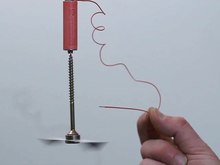Homopolar motor
A homopolar motor (also unipolar motor ) is a commutatorless direct current motor based on unipolar induction . The motor rotates along a fixed axis that is parallel to the magnetic field of a permanent magnet . Homopolar should indicate that the current is not commutated. Such motors necessarily consist of a single current loop . Since these motors can only generate small torques , their technical application is severely limited.
functionality
The homopolar motor is driven by the Lorentz force . This occurs when the charge carriers migrate to the center of the axis of rotation through the magnetic field generated by the small magnet and are deflected. Since the field lines of the magnetic field and the axis of rotation always point in the same direction, the motor rotates even without commutation . The advantage of simplicity is negated by the disadvantage of small torque. Like many other electrical machines, the homopolar motor is reversible . It can generate a DC voltage without a rectifier and without a commutator if the axis of rotation is mechanically rotated, and is then referred to as a unipolar generator .
Schematic representations
history
The first set-ups were demonstrated by Michael Faraday in the Royal Institution of London in 1821 . Another historical design of this type of engine is called the Barlow wheel .
building instructions
The homopolar motor can be recreated very easily. A permanent magnet generates the external magnetic field and a battery generates the electric current. The magnet does not necessarily have to move with it or be in contact with the axis of rotation. Its only purpose is to create the magnetic field.
Web links
- Homopolar Motor - 5 minutes ready to work
- The simplest electric motor in the world (PDF file; 289 kB)
swell
- ↑ See, eg, Richard P. Feynman , The Feynman Lectures on Physics , vol. II, section 17-2, (Reading, MA: Addison-Wesley, 1964). ISBN 0-201-02117-X
- ↑ Michael Faraday, "New Electro-Magnetic Apparatus," Quarterly Journal of Science, Literature and the Arts 12 , 186-187 (1821). Scanned pages
- ^ Michael Faraday, "Description of an Electro-magnetic Apparatus for the Exhibition of Rotatory Motion," Quarterly Journal of Science, Literature and the Arts 12 , 283-285 (1821). Scanned pages Original illustration ( plate ) of the homopolar motor, referred to on p. 283 of Faraday's second article . Index of Quarterly Journal for Faraday, Michael
- ^ "How the build the simplest electric motor" , from Evil Mad Scientist Laboratories , Aug. 7, 2006
- ↑ "How to make a homopolar motor ( Memento of the original from April 19, 2010 in the Internet Archive ) Info: The archive link was inserted automatically and has not yet been checked. Please check the original and archive link according to the instructions and then remove this note. , From Dangerously Fun , Jan. 31, 2007




